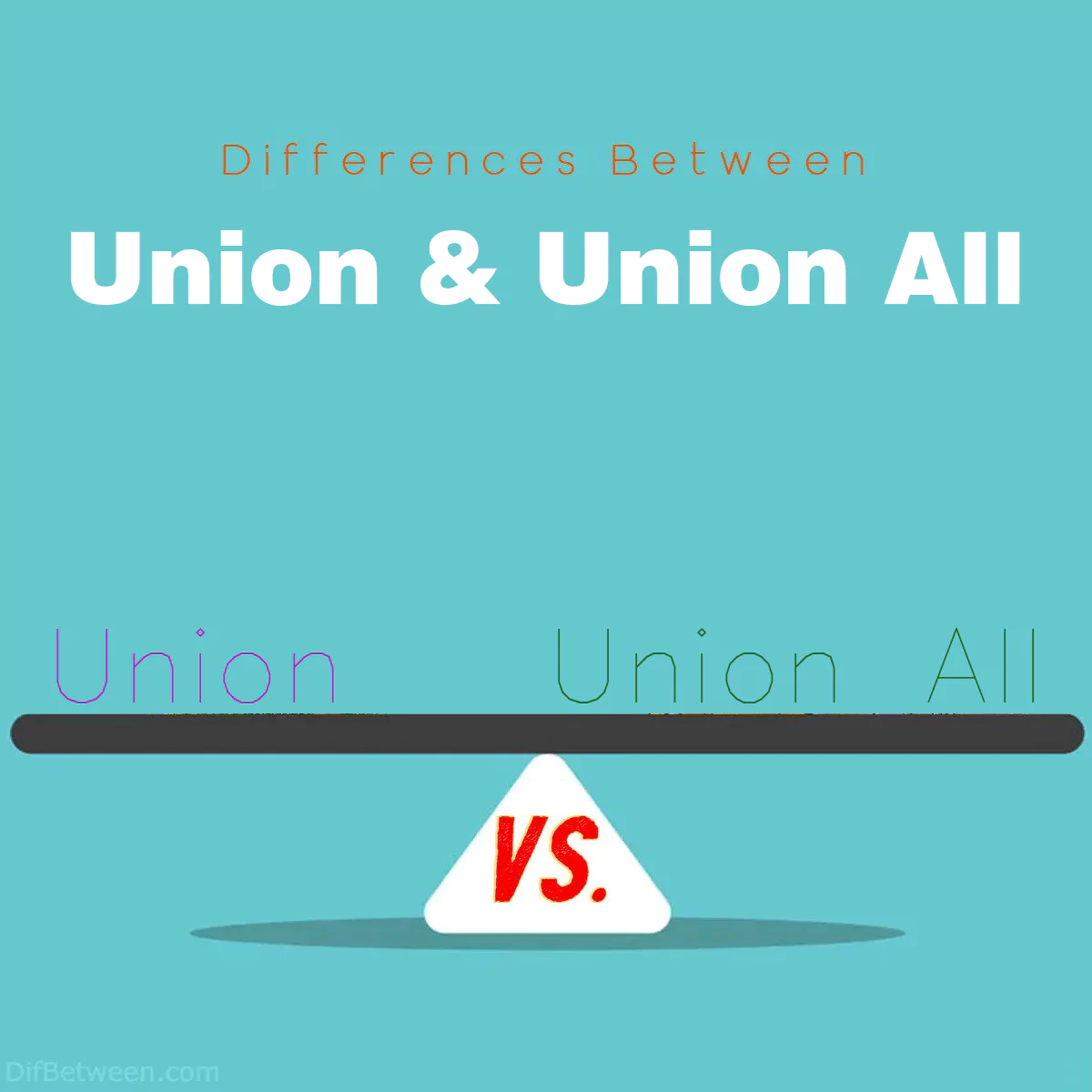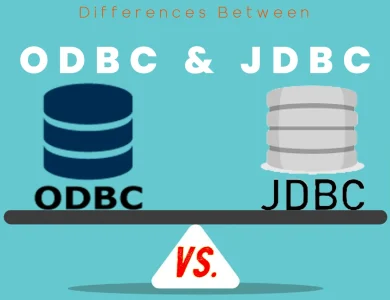
| Aspect | UNION | UNION ALL |
|---|---|---|
| Purpose | Combines and deduplicates result sets from multiple SELECT statements. | Combines result sets from multiple SELECT statements without deduplication. |
| Duplicate Rows | Eliminates duplicate rows from the final result. | Retains all rows from the participating SELECT statements, including duplicates. |
| Performance Considerations | Can introduce overhead due to duplicate removal. | Generally offers better performance, especially for large datasets, as it avoids duplicate removal. |
| Use Cases | – When you want unique, deduplicated results. – Maintaining data integrity by removing duplicate entries. – Displaying aggregated data. | – For raw data retrieval. – When query performance is crucial. – Preserving data context and the original data. |
| Syntax | SELECT ... FROM table1 UNION SELECT ... FROM table2; | SELECT ... FROM table1 UNION ALL SELECT ... FROM table2; |
When it comes to working with relational databases, SQL (Structured Query Language) is a vital tool for querying and manipulating data. Two commonly used SQL operations for combining data from multiple tables are UNION and UNION ALL. While they may seem similar at first glance, they serve distinct purposes and have key differences that can significantly impact your query results. In this comprehensive guide, we will explore these differences in detail.
Differences Between Union and Union All
The primary distinction between Union and Union All lies in how they handle duplicate rows when combining data from multiple tables in SQL. Union removes duplicate rows, ensuring that the result set contains only unique entries, making it ideal for scenarios where data integrity and distinct results are crucial. Conversely, Union All includes all rows from the source tables, even duplicates, making it more efficient for raw data retrieval and performance optimization, especially when dealing with large datasets. The choice between Union and Union All depends on your specific needs, with Union being used when you want to eliminate duplicates, and Union All chosen when you need all available data or want to avoid unnecessary processing.
1. Overview of UNION and UNION ALL <a name=”overview”></a>
Before diving into the differences, let’s establish a basic understanding of what UNION and UNION ALL do.
UNION
UNION is used to combine the result sets of two or more SELECT statements into a single result set. It removes duplicate rows from the final output, ensuring that each row in the result is unique. This operation is particularly useful when you want to merge data from multiple tables and ensure that there are no duplicate entries.
UNION ALL
On the other hand, UNION ALL also combines result sets, but it includes all rows from the participating SELECT statements, including duplicates. This means that if a row appears multiple times in any of the source tables, it will appear as many times in the final result set when using UNION ALL.
2. Eliminating Duplicate Rows <a name=”duplicate-rows”></a>
One of the most significant differences between UNION and UNION ALL is how they handle duplicate rows in the result set. Let’s explore this aspect in more detail.
UNION: Eliminating Duplicate Rows
When you use UNION, the operation automatically eliminates duplicate rows from the final result. This means that if you have the same row in both of the SELECT statements being combined, it will only appear once in the result set.
Consider the following example:
Table A
+----+--------+ | ID | Name | +----+--------+ | 1 | Alice | | 2 | Bob | | 3 | Carol | | 4 | Alice | +----+--------+Table B
+----+--------+ | ID | Name | +----+--------+ | 3 | Carol | | 4 | Alice | | 5 | Dave | +----+--------+If you use UNION to combine these two tables, the result will be:
Result using UNION
+----+--------+ | ID | Name | +----+--------+ | 1 | Alice | | 2 | Bob | | 3 | Carol | | 4 | Alice | | 5 | Dave | +----+--------+As you can see, the duplicate rows (e.g., ID 4 and Name “Alice”) are removed, and only unique rows are retained in the final result.
UNION ALL: Retaining Duplicate Rows
In contrast, when you use UNION ALL, all rows from the participating SELECT statements are included in the result, even if they are duplicates. Let’s see how the same example looks when using UNION ALL:
Result using UNION ALL
+----+--------+ | ID | Name | +----+--------+ | 1 | Alice | | 2 | Bob | | 3 | Carol | | 4 | Alice | | 3 | Carol | | 4 | Alice | | 5 | Dave | +----+--------+In this case, duplicate rows are preserved in the final result set. You can see that the rows with ID 3 and Name “Carol,” as well as ID 4 and Name “Alice,” appear multiple times because they exist in both source tables.
3. Performance Considerations <a name=”performance”></a>
The choice between UNION and UNION ALL can have a significant impact on the performance of your SQL queries, especially when dealing with large datasets. Let’s delve into the performance considerations of these operations.
UNION: Performance and Overhead
UNION involves the additional step of removing duplicate rows from the result set. This de-duplication process can introduce overhead, especially when dealing with large datasets with many duplicate entries. The database engine needs to compare and eliminate duplicates, which can slow down the query execution.
If you are certain that there are no duplicate rows in your result set or if you want to retain duplicates, using UNION may result in unnecessary processing and reduced query performance.
UNION ALL: Better Performance for Non-Distinct Results
UNION ALL, on the other hand, offers better performance in cases where you don’t need to eliminate duplicates. Since UNION ALL includes all rows from the source tables as is, it doesn’t incur the overhead of duplicate removal. This can lead to faster query execution, especially when dealing with large datasets.
In situations where you’re confident that your result set contains no duplicate rows or you want to preserve duplicates intentionally, using UNION ALL is the more efficient choice.
4. Use Cases <a name=”use-cases”></a>
The decision between UNION and UNION ALL should be based on your specific use case and the requirements of your query. Let’s explore common scenarios where each operation is more suitable.
When to Use UNION
- Eliminating Duplicate Entries: If you want to combine data from multiple tables and ensure that the result set contains unique rows only,
UNIONis the right choice. It’s useful when you need to merge data from distinct sources without worrying about duplicates. - Maintaining Data Integrity: In cases where duplicate rows may indicate data integrity issues, using
UNIONcan help you identify and resolve such problems by presenting only distinct records. - Displaying Aggregated Data: When you need to display aggregated data and want to avoid double-counting,
UNIONis beneficial. It ensures that each entity is counted only once.
When to Use UNION ALL
- Raw Data Retrieval: If your goal is to retrieve raw data from multiple sources without any data transformation or deduplication,
UNION ALLis the more efficient choice. It provides faster query execution and includes all rows from the source tables. - Performance Optimization: In situations where query performance is crucial, and you are confident that there are no duplicate rows,
UNION ALLis a better option. It eliminates the overhead associated with duplicate removal. - Preserving Data Context: When it’s essential to maintain the context of the original data, such as when you want to analyze data distribution,
UNION ALLensures that no information is lost.
5. Syntax Comparison <a name=”syntax”></a>
Both UNION and UNION ALL share a similar syntax when it comes to combining result sets. However, there’s a subtle difference in how they handle duplicates. Let’s compare their syntax:
UNION Syntax
SELECT column1, column2, ... FROM table1 UNION SELECT column1, column2, ... FROM table2;UNION ALL Syntax
SELECT column1, column2, ... FROM table1 UNION ALL SELECT column1, column2, ... FROM table2;As you can see, the only difference in syntax is the use of the keyword ALL after UNION in the UNION ALL query. This simple addition changes the behavior of the operation, either removing duplicates (UNION) or preserving duplicates (UNION ALL).
Union or Union All : Which One is Right Choose for You?
When working with SQL queries and relational databases, the choice between UNION and UNION ALL is a critical one, as it can significantly impact your query results and performance. Let’s explore which option is the right choice for you based on your specific needs and use cases.
When to Choose UNION
1. Eliminating Duplicate Entries
Use UNION when you want to combine data from multiple tables and ensure that the result set contains unique, deduplicated rows. This is particularly useful when:
- Merging data from distinct sources: If you’re bringing together data from various tables and need to remove duplicates,
UNIONis the way to go. - Ensuring data integrity: When duplicate rows might indicate data quality or integrity issues,
UNIONhelps you identify and address such problems by presenting only distinct records. - Displaying aggregated data: If you’re performing aggregate functions and want to avoid double-counting or redundancy in your results,
UNIONensures that each entity is counted only once.
2. Maintaining Data Quality
UNION can be your choice when data quality and consistency are paramount. It ensures that the final result set contains only unique rows, which can be crucial in scenarios where duplicate data can lead to erroneous analysis or decision-making.
3. Displaying Cleaned Data
When you want to present data to end-users or stakeholders in a clean and easy-to-understand format, UNION helps you achieve that by removing duplicate entries and providing a more streamlined result set.
When to Choose UNION ALL
1. Raw Data Retrieval
If your primary goal is to retrieve raw data from multiple sources without any data transformation or deduplication, UNION ALL is the more efficient choice. Consider using it in the following situations:
- You need all available data:
UNION ALLincludes all rows from the source tables, even if they are duplicates. This is ideal when you want a complete snapshot of your data. - Performance optimization: In scenarios where query performance is crucial, and you are confident that there are no duplicate rows,
UNION ALLcan deliver faster results by avoiding the overhead of duplicate removal.
2. Preserving Data Context
When maintaining the context of the original data is essential, such as when you’re analyzing data distribution or need to maintain the relationships between data points, UNION ALL ensures that no information is lost during the merging process.
3. Avoiding Unnecessary Processing
If you know that your result set doesn’t contain duplicates or you intentionally want to retain duplicates, opting for UNION ALL eliminates unnecessary processing, making your query more efficient.
In conclusion, the choice between UNION and UNION ALL depends on your specific requirements and goals:
- Use
UNIONwhen you need to eliminate duplicate entries, maintain data integrity, or display aggregated data with unique results. - Opt for
UNION ALLwhen you want to retrieve raw data efficiently, preserve data context, optimize query performance, or intentionally retain duplicates.
Understanding the distinctions between these two SQL operations and selecting the right one for your task will enable you to craft more effective and efficient SQL queries while working with relational databases.
FAQs
The primary difference is how they handle duplicate rows. Union removes duplicate rows, ensuring unique results, while Union All includes all rows, including duplicates.
Union is ideal when you want to merge data from multiple tables and ensure that the result set contains unique, deduplicated rows. It’s helpful for maintaining data integrity and displaying aggregated data.
Union All is the preferred choice when you need all available data without deduplication. It’s efficient for raw data retrieval and can optimize query performance, especially with large datasets.
Yes, Union can introduce overhead due to duplicate removal, which might impact query performance, especially with extensive data. If duplicates are not a concern, consider Union All for better performance.
Yes, you can use both Union and Union All in the same query, depending on your specific data merging needs within different parts of the query.
The syntax for both operations is quite similar. The only distinction is the inclusion of the keyword “ALL” after “UNION” in Union All queries.
The choice depends on your specific use case. Use Union when you need to eliminate duplicates and ensure data integrity. Choose Union All when you require all available data or want to optimize performance, especially for large datasets.
Yes, you can use Union or Union All with as many SELECT statements as needed to merge data from multiple tables or sources.
Union All generally offers better performance because it avoids duplicate removal. If performance is crucial and duplicates are not a concern, Union All is a more efficient option.
Generally, yes. Union and Union All are standard SQL operations supported by most relational database systems. However, there might be slight variations in syntax or behavior between database systems, so it’s essential to consult your database’s documentation for specific details.
Read More :
Contents






